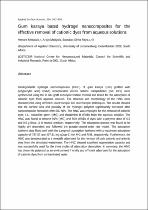 ResearchSpace
ResearchSpace
Gum karaya based hydrogel nanocomposites for the effective removal of cationic dyes from aqueous solutions
JavaScript is disabled for your browser. Some features of this site may not work without it.
- ResearchSpace
- →
- Research Publications/Outputs
- →
- Journal Articles
- →
- View Item
| dc.contributor.author |
Mittala, H

|
|
| dc.contributor.author |
Maity, Arjun

|
|
| dc.contributor.author |
Ray, Suprakas S

|
|
| dc.date.accessioned | 2017-02-23T10:04:28Z | |
| dc.date.available | 2017-02-23T10:04:28Z | |
| dc.date.issued | 2016-02 | |
| dc.identifier.citation | Mittala, H., Maity, A. and Ray, S.S. 2016. Gum karaya based hydrogel nanocomposites for the effective removal of cationic dyes from aqueous solutions. Applied Surface Science, 364, pp917-930 | en_US |
| dc.identifier.issn | 0169-4332 | |
| dc.identifier.uri | http://www.sciencedirect.com/science/article/pii/S0169433216000064 | |
| dc.identifier.uri | http://hdl.handle.net/10204/8976 | |
| dc.description | Copyright: 2016 Elsevier. . Due to copyright restrictions, the attached PDF file only contains the abstract of the full text item. For access to the full text item, please consult the publisher's website. The definitive version of the work is published in the Applied Surface Science, 364, 917-930 | en_US |
| dc.description.abstract | Biodegradable hydrogel nanocomposites (HNC) of gum karaya (GK) grafted with poly(acrylic acid) (PAA) incorporated silicon carbide nanoparticles (SiC NPs) were synthesized using the in situ graft copolymerization method and tested for the adsorption of cationic dyes from aqueous solution. The structure and morphology of the HNC were characterized using different spectroscopic and microscopic techniques. The results showed that the surface area and porosity of the hydrogel polymer significantly increased after nanocomposite formation with SiC NPs. The HNC was employed for the removal of cationic dyes, i.e., malachite green (MG) and rhodamine B (RhB) from the aqueous solution. The HNC was found to remove 91% (MG) and 86% (RhB) of dyes with a polymer dose of 0.5 and 0.6 g l(sup-1) in neutral medium, respectively. The adsorption process was found to be highly pH dependent and followed the pseudo-second-order rate model. The adsorption isotherm data fitted well with the Langmuir adsorption isotherm with a maximum adsorption capacity of 757.57 and 497.51 mg g(sup-1) for MG and RhB, respectively. Furthermore, the HNC was demonstrated as a versatile adsorbent for the removal of both cationic and anionic dyes from the simulated wastewater. The HNC showed excellent regeneration capacity and was successfully used for the three cycles of adsorption–desorption. In summary, the HNC has shown its potential as an environment friendly and efficient adsorbent for the adsorption of cationic dyes from contaminated water. | en_US |
| dc.language.iso | en | en_US |
| dc.publisher | Elsevier | en_US |
| dc.relation.ispartofseries | Wokflow;17675 | |
| dc.subject | Gum karaya | en_US |
| dc.subject | Silicon carbide NPs | en_US |
| dc.subject | Nanocomposites | en_US |
| dc.subject | Adsorption | en_US |
| dc.subject | Malachite green | en_US |
| dc.subject | Rhodamine B | en_US |
| dc.title | Gum karaya based hydrogel nanocomposites for the effective removal of cationic dyes from aqueous solutions | en_US |
| dc.type | Article | en_US |
| dc.identifier.apacitation | Mittala, H., Maity, A., & Ray, S. S. (2016). Gum karaya based hydrogel nanocomposites for the effective removal of cationic dyes from aqueous solutions. http://hdl.handle.net/10204/8976 | en_ZA |
| dc.identifier.chicagocitation | Mittala, H, Arjun Maity, and Suprakas S Ray "Gum karaya based hydrogel nanocomposites for the effective removal of cationic dyes from aqueous solutions." (2016) http://hdl.handle.net/10204/8976 | en_ZA |
| dc.identifier.vancouvercitation | Mittala H, Maity A, Ray SS. Gum karaya based hydrogel nanocomposites for the effective removal of cationic dyes from aqueous solutions. 2016; http://hdl.handle.net/10204/8976. | en_ZA |
| dc.identifier.ris | TY - Article AU - Mittala, H AU - Maity, Arjun AU - Ray, Suprakas S AB - Biodegradable hydrogel nanocomposites (HNC) of gum karaya (GK) grafted with poly(acrylic acid) (PAA) incorporated silicon carbide nanoparticles (SiC NPs) were synthesized using the in situ graft copolymerization method and tested for the adsorption of cationic dyes from aqueous solution. The structure and morphology of the HNC were characterized using different spectroscopic and microscopic techniques. The results showed that the surface area and porosity of the hydrogel polymer significantly increased after nanocomposite formation with SiC NPs. The HNC was employed for the removal of cationic dyes, i.e., malachite green (MG) and rhodamine B (RhB) from the aqueous solution. The HNC was found to remove 91% (MG) and 86% (RhB) of dyes with a polymer dose of 0.5 and 0.6 g l(sup-1) in neutral medium, respectively. The adsorption process was found to be highly pH dependent and followed the pseudo-second-order rate model. The adsorption isotherm data fitted well with the Langmuir adsorption isotherm with a maximum adsorption capacity of 757.57 and 497.51 mg g(sup-1) for MG and RhB, respectively. Furthermore, the HNC was demonstrated as a versatile adsorbent for the removal of both cationic and anionic dyes from the simulated wastewater. The HNC showed excellent regeneration capacity and was successfully used for the three cycles of adsorption–desorption. In summary, the HNC has shown its potential as an environment friendly and efficient adsorbent for the adsorption of cationic dyes from contaminated water. DA - 2016-02 DB - ResearchSpace DP - CSIR KW - Gum karaya KW - Silicon carbide NPs KW - Nanocomposites KW - Adsorption KW - Malachite green KW - Rhodamine B LK - https://researchspace.csir.co.za PY - 2016 SM - 0169-4332 T1 - Gum karaya based hydrogel nanocomposites for the effective removal of cationic dyes from aqueous solutions TI - Gum karaya based hydrogel nanocomposites for the effective removal of cationic dyes from aqueous solutions UR - http://hdl.handle.net/10204/8976 ER - | en_ZA |





